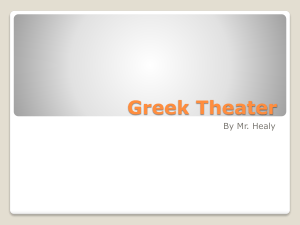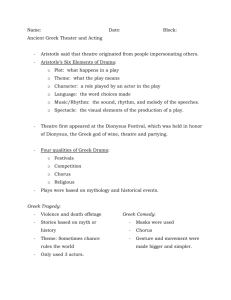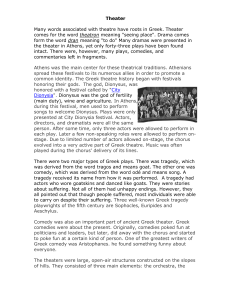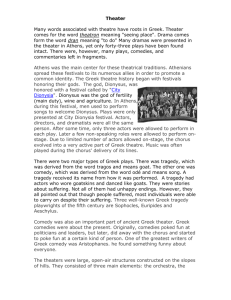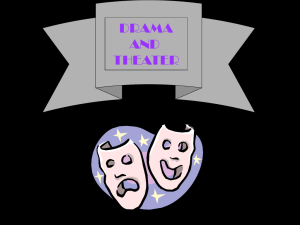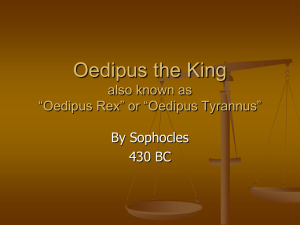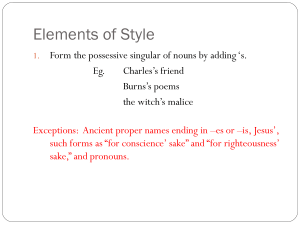Introduction to Antigone
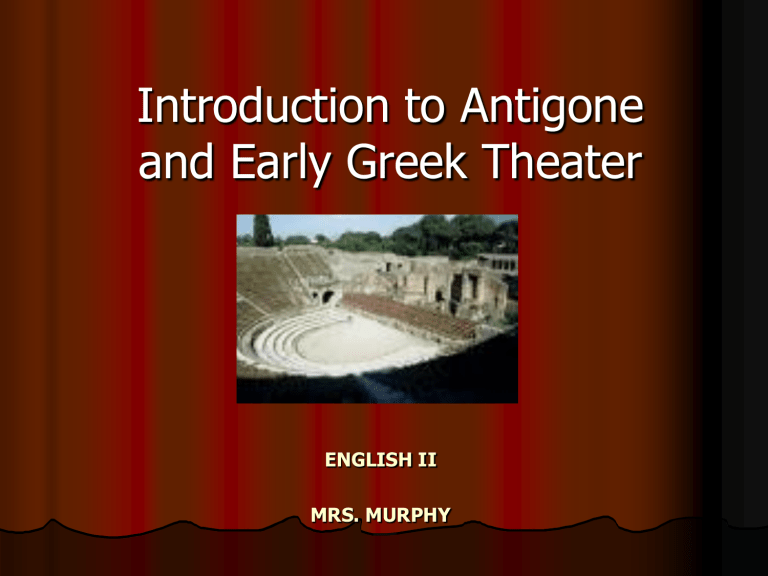
Introduction to Antigone and Early Greek Theater
ENGLISH II
MRS. MURPHY
What comes to mind when you hear the word Greece?
What do you think of when you hear the word theater?
Origins of Drama
Drama began during the sixth century, B.C. as part of a religious festival that was intended to honor the god
Dionysos , the god of wine, agriculture and fertility.
These festivals were held annually in March and followed certain rituals, or patterns. Festival goers spent an entire week drinking wine and worshiping the phallus.
The early Greeks also spent much time singing chants
(while very drunk) in order to praise Dionysos.
Origins of Drama
While drunk and singing these songs of praise, worshipers also danced around an altar. This group of people were called a chorus .
Eventually a man named Thespis began to write down these songs and revised them so that they would tell a story.
After a while Thespis decided to have one member of the chorus step away from the others to play the part of a hero or god. He wore a special mask and began talking to the chorus. This was the first character !
Continuing Changes in Drama
The modern theater we know today has his origins in Greek drama as well. A man named Aeschylus decided to add a second character to the performance. The second character allowed conflict to be shown on the stage.
Now that conflict was able to be seen on stage, drama as we know it was born.
The First Greek Theaters
The first theaters were all outdoors and were called amphitheaters .
Many resembled a semi-circular football stadium. Seats were carved out of stone on a hillside. The stage area was at the bottom and was where the chorus members sang and danced around an altar.
What were early Greek plays about?
When many think of ancient
Greece, they imagine white pillars and elaborately dressed gods and goddesses in a calm and serene setting.
The early Greek plays were anything but calm and dealt with topics such as war, murder, lust, and betrayal.
These early plays were also either a tragedy or a comedy .
Parts of a Greek Theater
The earliest Greek theaters had four major parts:
the orchestra —the circular area of the theater where the actors would sing and dance the theatron —where attendees would sit to view the action
the parados —a long narrow passageway that actors used to make entrances and exits the skene —a building located behind the stage that was designed to look like a temple, palace or other structure needed. It served as a prop and also allowed actors to make entrances and exits
Costumes and Props in Early
Greek Drama
Actors in these early plays did not rely on elaborate costumes to tell the characters apart. Instead they used huge masks to distinguish between characters.
Using masks also allowed actors to play one than more role. The only costume change involved was adding a new mask.
The masks had very large mouthpieces that amplified the sound of the actors’ voices, and often had large eye openings as well. (Remember no microphones were available during this time.) These masks usually represented familiar characters that would be easily recognized by the audience.
Greek Masks (cont.)
Colors were used in the masks as well to convey emotion.
Most were some shade of red since there were made of terra cotta.
Wigs were also frequently added to help distinguish between characters.
Today the symbols of the mask has come to symbolize theater worldwide.
Examples of Greek Masks
The First Actors
The first actors were all men, despite whether their role was male or female.
To represent a female character, the actor would use a mask with womanly features.
Because it was quick and easy to change the masks that distinguished characters, actors often played several roles within a single play.
Assignment Time
Today we discussed the origins of Greek drama, and we learned that the actors relied on masks to help the audience distinguish between characters in the play.
Create a mask that could have been used by these early Greeks. You may choose whether your character is male or female, but your mask must demonstrate the key characteristics of the early Greek masks. After your mask is complete, write a paragraph that explains why your mask is like those of the early Greeks.

